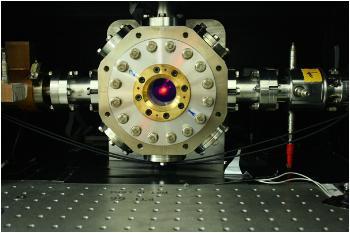Royal Holloway University of London
Optimisation of the layout of the LHC collimation system
Trainee: Hector Garcia
Supervisor: Steward Boogert
Machine related backgrounds arise mainly either from the halo that accompanies the core beam or from accidental losses due to individual events. Particles at large displacements from the core can impact on beam-line apertures, including collimators, and then exit the beam-pipe downstream. Looking towards the initial LHC upgrades, an ESR project at RHUL will look into an optimisation of the layout of the LHC collimation system to minimize beam related backgrounds in the ATLAS detector at CERN and also look into optimizing the LHC injection region to minimize activation in that region. The material interactions will be simulated using BDSIM and will then be cross-checked with FLUKA simulations performed at CERN.
The multi-turn tracking will be performed using SIXTRACK and a suitable interface provided to streamline the transfer of large-amplitude particles to BDSIM. The beam loss monitors will be modeled in Geant4 and included within the BDSIM package; in this way an accurate modeling of the response of the LHC to beam losses will be obtained.
Video:
Laser-wire beam profile monitor for measuring the transverse beam profile of an H-beam
Trainee: Konstantin Kruchinin
Supervisor: Pavel Karataev
Laser-wire systems employ laser beams to scan accelerated particle beams to determine their transverse profile. They are well suited to operation at high power or low emittance machines because they are relatively non-invasive devices and they cannot be destroyed by the beam they are measuring. The project aims to develop a laser wire beam profile monitor for measuring the transverse beam profile of an H- beam.
First step of the project involves the participation in experiment at KEK-ATF/ATF2 facility to learn the state-of-the-art system in laser-based diagnostics of transverse electron beam size. During this period, laser transport and diagnostics, hands-on experience of the accelerator complex operation, the laser-wire data acquisition and analysis software will be studied. Study also includes the experiment on sub-micrometer optical transition radiation beam size diagnostics for comparison with the laser-wire.

The laser-wire experimental setup for beam profile measurements at KEK-ATF/ATF2
Afterwards the project will develop a laser-wire system to measure the transverse profile and emittance of an H- ion beam being constructed at Front End Test Stand at Rutherford Appleton Lab (RAL). Project involves collaboration with the ongoing work at RAL; designing a detector test stand simulating photo-detached particles to develop a new type detector. Particular challenges include the novel use of fiber lasers and the use of fibers for light transport. This project will involve significant design effort in collaboration with the Linac4 machine physicists at CERN.
Scientist in Charge: